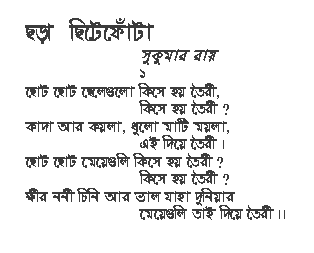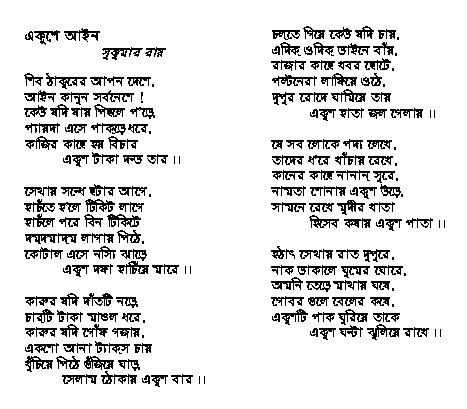


C










 Satyajit Ray (2 May 1921–23 April 1992)
Satyajit Ray (2 May 1921–23 April 1992)











 Satyajit Ray (2 May 1921–23 April 1992)
Satyajit Ray (2 May 1921–23 April 1992)
was an Indian Bengali filmmaker. Ray is regarded as one of the greatest auteurs of 20th century cinema.[1] Born in the city of Calcutta (now Kolkata) into a Bengali family prominent in the world of arts and letters, Ray studied at Presidency College and at the Visva-Bharati University. Starting his career as a commercial artist, Ray was drawn into filmmaking after meeting French filmmaker Jean Renoir and viewing the Italian neorealist film Bicycle Thieves during a visit to London.
Ray directed thirty-seven films, including feature films, documentaries and shorts. He was also a fiction writer, publisher, illustrator, graphic designer and film critic. Ray's first film, Pather Panchali, won eleven international prizes, including Best Human Document at the Cannes film festival. Along with Aparajito and Apur Sansar, the film forms the Apu trilogy. Ray did the scripting, casting, scoring, cinematography, art direction, editing and designed his own credit titles and publicity material. Ray received many major awards, including 32 National Film Awards, a number of international awards, and an Academy Honorary Award in 1992.
Ray directed thirty-seven films, including feature films, documentaries and shorts. He was also a fiction writer, publisher, illustrator, graphic designer and film critic. Ray's first film, Pather Panchali, won eleven international prizes, including Best Human Document at the Cannes film festival. Along with Aparajito and Apur Sansar, the film forms the Apu trilogy. Ray did the scripting, casting, scoring, cinematography, art direction, editing and designed his own credit titles and publicity material. Ray received many major awards, including 32 National Film Awards, a number of international awards, and an Academy Honorary Award in 1992.
Ray created two very popular characters in Bengali children's literature—Feluda, a sleuth, and Professor Shonku, a scientist. He was a prominent writer of science fiction in Bengali or any Indian language for that matter. He also wrote short stories which were published as volumes of 12 stories, always with names playing on the word twelve (for example Aker pitthe dui, or literally "Two on top of one"). Ray's interest in puzzles and puns is reflected in his stories, Feluda often has to solve a puzzle to get to the bottom of a case. The Feluda stories are narrated by Topshe, his cousin, something of a Watson to Feluda's Holmes. The science fictions of Shonku are presented as a diary discovered after the scientist himself had mysteriously disappeared. Ray's short stories give full reign to his interest in the macabre, in suspense and other aspects that he avoided in film, making for an interesting psychological study.[48] Most of his writings have now been translated into English, and are finding a new group of readers.
Most of his screenplays have also been published in Bengali in the literary journal Eksan. Ray wrote his autobiography encompassing his childhood years, Jakhan Choto Chilam (1982) and essays on film: Our Films, Their Films (1976), along with Bishoy Chalachchitra (1976), Ekei Bole Shooting (1979). During the mid-1990s, Ray's film essays and an anthology of short stories were also published in the West. Our Films, Their Films is an anthology of film criticism by Ray. The book contains articles and personal journal excerpts. The book is presented in two sections—Ray first discusses Indian film, before turning his attention towards Hollywood and specific international filmmakers (Charlie Chaplin, Akira Kurosawa) and movements like Italian neorealism. His book Bishoy Chalachchitra was translated in 2006 as Speaking of Films, and contains a compact description of his philosophy of different aspects of the cinema. Ray also wrote a collection of nonsense verse named Today Bandha Ghorar Dim, which includes a translation of Lewis Carroll's "Jabberwocky". He also authored a collection of humorous stories of Mullah Nasiruddin in Bengali.
Satyajit Ray designed four typefaces for roman script named Ray Roman, Ray Bizarre, Daphnis, and Holiday Script, apart from numerous Bengali ones for the Sandesh magazine.[49][50] Ray Roman and Ray Biazarre won an international competition in 1971.[51] In certain circles of Kolkata, Ray continued to be known as an eminent graphic designer, well into his film career. Ray illustrated all his books and designed covers for them, as well as creating all publicity material for his films. He also designed covers of several books by other authors
Most of his screenplays have also been published in Bengali in the literary journal Eksan. Ray wrote his autobiography encompassing his childhood years, Jakhan Choto Chilam (1982) and essays on film: Our Films, Their Films (1976), along with Bishoy Chalachchitra (1976), Ekei Bole Shooting (1979). During the mid-1990s, Ray's film essays and an anthology of short stories were also published in the West. Our Films, Their Films is an anthology of film criticism by Ray. The book contains articles and personal journal excerpts. The book is presented in two sections—Ray first discusses Indian film, before turning his attention towards Hollywood and specific international filmmakers (Charlie Chaplin, Akira Kurosawa) and movements like Italian neorealism. His book Bishoy Chalachchitra was translated in 2006 as Speaking of Films, and contains a compact description of his philosophy of different aspects of the cinema. Ray also wrote a collection of nonsense verse named Today Bandha Ghorar Dim, which includes a translation of Lewis Carroll's "Jabberwocky". He also authored a collection of humorous stories of Mullah Nasiruddin in Bengali.
Satyajit Ray designed four typefaces for roman script named Ray Roman, Ray Bizarre, Daphnis, and Holiday Script, apart from numerous Bengali ones for the Sandesh magazine.[49][50] Ray Roman and Ray Biazarre won an international competition in 1971.[51] In certain circles of Kolkata, Ray continued to be known as an eminent graphic designer, well into his film career. Ray illustrated all his books and designed covers for them, as well as creating all publicity material for his films. He also designed covers of several books by other authors
About forty years of filmmaking, with a film a year, was interrupted by his fragile health in the mid-1980s. Ray's Ghare-Baire (Home and the World, 1984) based on a novel by Rabindranath Tagore, was a return to his first screen adaptation. While shooting, he suffered two heart attacks and his son, Sandip Ray, completed the project from his detailed instructions.
1989-1992 Ill health kept Satyajit Ray away from active filmmaking for about four years. In 1989, he resumed making films with Ibsen's An Enemy of the People as the basis for his Ganashatru (Enemy of the People, 1989). This was followed with Shakha Prashakha (Branches of the Tree, 1990) and Agantuk (The Stranger, 1991). This series of three films were to be his last. Many film critics and film historians found these films a marked departure from his earlier work. In 1992, He accepted a Lifetime Achievement Oscar from his sickbed in Calcutta through a special live satellite-television event and Bharat Ratna (the Jewel of India), the ultimate honour from India. Satyajit Ray died on April 23, 1992, leaving behind the an immortal legend that will last through the ages.
1989-1992 Ill health kept Satyajit Ray away from active filmmaking for about four years. In 1989, he resumed making films with Ibsen's An Enemy of the People as the basis for his Ganashatru (Enemy of the People, 1989). This was followed with Shakha Prashakha (Branches of the Tree, 1990) and Agantuk (The Stranger, 1991). This series of three films were to be his last. Many film critics and film historians found these films a marked departure from his earlier work. In 1992, He accepted a Lifetime Achievement Oscar from his sickbed in Calcutta through a special live satellite-television event and Bharat Ratna (the Jewel of India), the ultimate honour from India. Satyajit Ray died on April 23, 1992, leaving behind the an immortal legend that will last through the ages.














